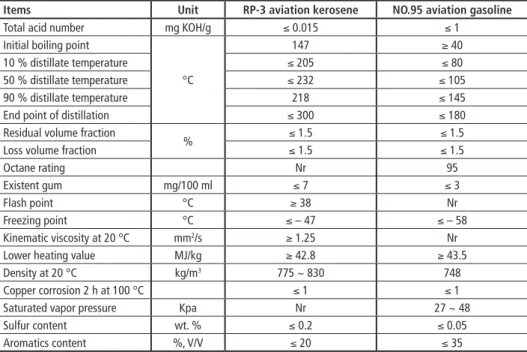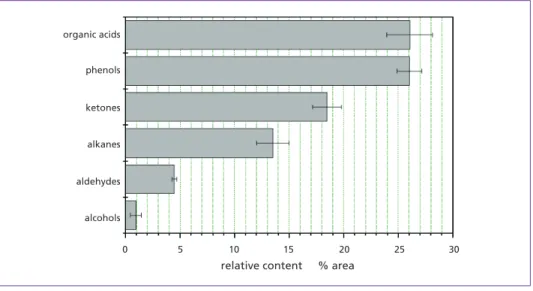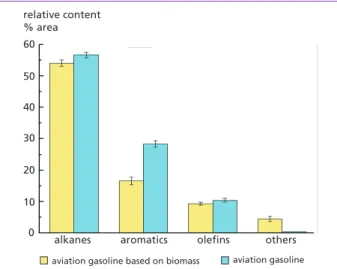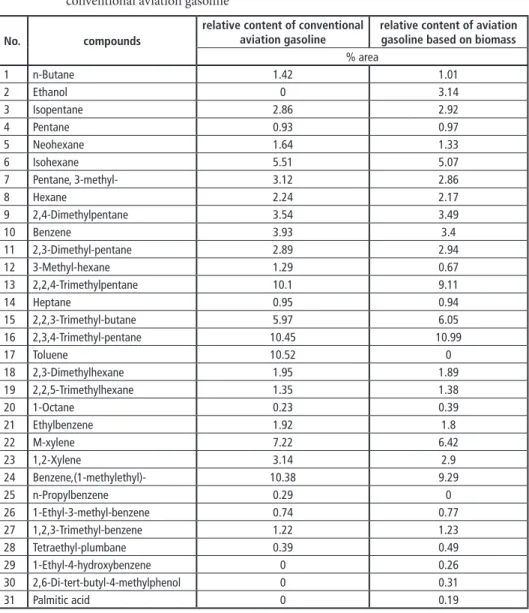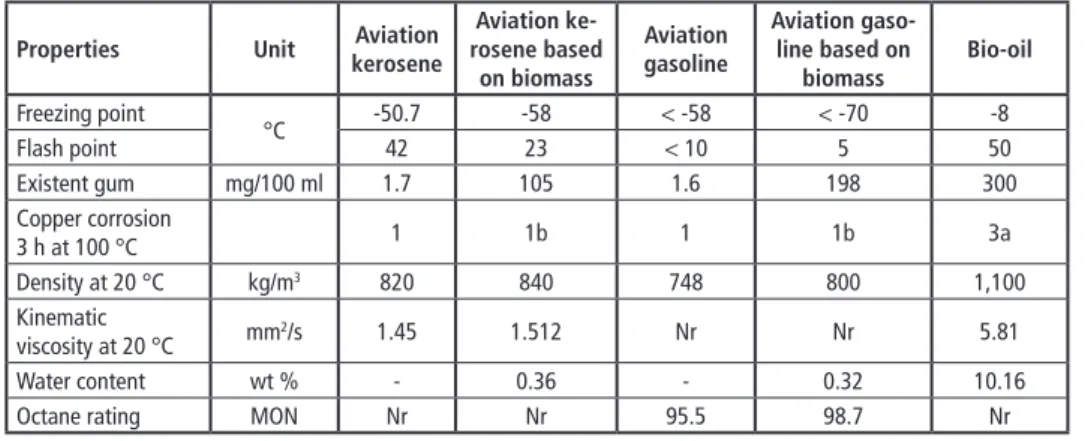Pyrolysis/Gasification
Evaluation on Physical and Chemical Properties of Aviation Biofuels from Corn Straw Oil by Hydrothermal Liquefaction
Based on Chemical-Biological Pretreatment
Bingshuo Li, Jian Wang, Tianhua Yang, Rundong Li, Weidan Wang and Yinghui Xie
1. Introduction ...384
2. Materials and methods ...385
2.1. Materials and reagents ...385
2.2. Measurement methods and instruments ...387
3. Results and discussion ...387
3.1. Comparison of the chemical compositions of aviation biofuels and aviation fuels ...387
3.2. Physical and chemical properties of aviation biofuels ...390
3.2.1. Total acid number and lower heating value of aviation biofuels ...390
3.2.2. Freezing point and flash point of aviation biofuels ...391
3.2.3. Density and kinematic viscosity of aviation biofuels ...392
3.2.4. Octane rating and water content of aviation biofuels ...392
3.2.5. Existent gum contents and copper corrosion grades of aviation biofuels ...392
4. Conclusion ...393
5. Literature ...393
This study extended previous work investigating aviation fuels and a 1:1 (by volume) blend of those fuel with a biofuel derived from corn straw oil prepared by the hydro- thermal liquefaction of chemical-biological pretreated. The results showed that the aviation kerosene based on biomass and aviation gasoline based on biomass exhibited 3 and 0.11 MJ/kg higher heating values, 53.6- and 1.5-fold higher total acid numbers, 14.4 % and 20.7 % lower freezing points, and 62- and 123-fold higher existent gum contents, respectively. Bio-oil from hydrothermal liquefaction based on chemical-bi- ological pretreatment could be compatible with aviation kerosene by esterification or catalytic hydrogenation.
Pyrolysis/Gasification
1. Introduction
In recent years, the rapid development of the aviation industry has led to sudden increas- es in the consumption of aviation fuel, resulting in elevated emissions of greenhouse gases. The consumption of aviation fuel accounts for 2 % of the total consumption of fossil fuels, equivalent to 12 % of the fuel consumption in the transportation sector.
However, many challenges remain before aviation biofuels can be widely adopted, particularly with regard to cost and sustainability. A biomass-based fuel has proved to have the great potential to replace petroleum-derived aviation fuels [9].
At present, biofuel blending substitute conventional aviation fuels for aviation biofuels is the most potential method [7]. Therefore, both the production of bio-oil by using stalk and the upgrading of the aviation biofuels utilization technologies have attract- ed much research attention in recent years [10]. The key to achieving this goal is a technology through which the stalk can be liquefied to bio-oil [1]. Sub-Supercritical Fluid Technology can enhance the mass transfer between stalk and the solvent [3].
Additionally, the reaction time is shorter than the traditional pyrolysis reaction, the residue and the gas produced are little in quantity, the efficiency is high while the cost is low. Researchers currently either use water or an organic solvent as a medium. Easy availability, low price and potential for industrial application are the characteristics which make water a suitable choice for being the reaction medium. Due to strong dissolution abilities for reactants and products, ethanol is the most favoured medi- um among organic compounds. However, if the bio-oil is used as an alternative fuel, ethanol, which is used as a medium, does not need to be excluded from the product.
Production of bio-oil from water and alcohol by using eco-friendly technology of Sub- and Supercritical fluid has attracted much research attention in recent years. Uti- lizing bio-oil from the hydrothermal liquefaction of lignocellulose straw to synthesize aviation biofuels has become a focus of investigation, but the complex structures and range of constituents of lignocellulose have become obstacles to improving the yield and quality of the bio-oil.
Previous studies by our group [5] have shown that pretreating corn straw using ac- id-alkali solution and yeast (called chemical-biological pretreatment) could destroy the lignin structure and expose the bare cellulose and hemicelluloses to acid solution for conversion into sugars. During the fermentation process, the sugars are consumed by the yeast to produce ethanol, a potential material of hydrothermal liquefaction. Preparing bio-oil by the hydrothermal liquefaction of chemical-biological pretreated corn straw could decrease the variety of chemical constituents of the bio-oil and increase the yield of bio-oil while enhancing its content of chemical constituents that possess qualities of antidetonation and inoxidisability, such as toluene, 4-hydroxy-4-methyl-2-pentanone, and 2,6-di-tert-butyl-4-methylphenol, enabling its potential as an excellent biofuel.
Aviation biofuels were prepared by directly mixing aviation fuels with bio-oil from the hydrothermal liquefaction of chemical-biological pretreated corn straw in this paper. Over the course of this work the compatibility of bio-oil with aviation fuels was assessed by analysing the physical and chemical properties of aviation biofuels, which aims to provide the corresponding guidance for preparation and upgrading of bio-oil.
Pyrolysis/Gasification
2. Materials and methods 2.1. Materials and reagents
RP-3 aviation kerosene and NO.95 aviation gasoline were provided by a petrochemical company, and their major specifications were shown in Table 1. Chemical-biological pretreated corn straw was the material for the preparation of the bio-oil.
Table 1: Major specifications of RP-3 aviation kerosene and NO.95 aviation gasoline
Items Unit RP-3 aviation kerosene NO.95 aviation gasoline
Total acid number mg KOH/g ≤ 0.015 ≤ 1
Initial boiling point
°C
147 ≥ 40
10 % distillate temperature ≤ 205 ≤ 80
50 % distillate temperature ≤ 232 ≤ 105
90 % distillate temperature 218 ≤ 145
End point of distillation ≤ 300 ≤ 180
Residual volume fraction
% ≤ 1.5 ≤ 1.5
Loss volume fraction ≤ 1.5 ≤ 1.5
Octane rating Nr 95
Existent gum mg/100 ml ≤ 7 ≤ 3
Flash point °C ≥ 38 Nr
Freezing point °C ≤ – 47 ≤ – 58
Kinematic viscosity at 20 °C mm2/s ≥ 1.25 Nr
Lower heating value MJ/kg ≥ 42.8 ≥ 43.5
Density at 20 °C kg/m3 775 ~ 830 748
Copper corrosion 2 h at 100 °C ≤ 1 ≤ 1
Saturated vapor pressure Kpa Nr 27 ~ 48
Sulfur content wt. % ≤ 0.2 ≤ 0.05
Aromatics content %, V/V ≤ 20 ≤ 35
Nr: not required
Based on our previous research [5], the autoclave was heated to the desired temperature (370 °C) for 30 minutes by a heating jacket. After the reaction, the autoclave was cooled to 25 °C by cool water, and the gas was exhausted via an exhaust valve. The collection and separation process of the products were shown in Figure 1. Figure 2 and Table 2 showed the chemical compositions of bio-oil.
autoclave gas washing with acetone, ethanol and
methylene dichloride
organic solution and solid liquid and solid filtration
filtration
solid 2 solid 1 aqueous phase washing with acetone and ethanol organic solution 1 organic solution 2
bio-oil solid
drying evaporation
Figure 1:
Collection and separation pro- cedure of liquefaction products
Pyrolysis/Gasification
Figure 2: Relative content of several compounds in bio-oil Table 2: Main components of bio-oil
0 5 10 15 20 25 30
alcohols aldehydes alkanes ketones phenols organic acids
relative content % area
No. Compounds RT
min
Relative content
% area
1 Ethanol 1.355 0.95
2 Toluene 2.764 0.65
3 Cyclopentanone 3.060 0.71
4 2-Methylcyclopentanone 3.815 0.79
5 Diacetone alcohol 3.858 1.67
6 3-Methylcyclopentanone 3.936 0.69
7 Methyl cyclopentenolone 5.036 2.11
8 (Z)-4-Decenal 5.586 0.55
9 3-Methyl-2-cyclopenten-1-one 6.190 1.78
10 Phenol 7.114 2.12
11 Thujone 7.199 1.77
12 2,3-Dimethyl-2-cyclopentenone 7.495 5.21
13 trans,trans-2,4-Heptadienal 8.196 1.05
14 Cinnamaldehyde 8.728 3.92
15 4-Ethylphenol 10.075 2.47
16 4-Ethyl-2-methoxyphenol 11.422 19.99
17 1-Indanone 11.513 3.12
18 3,3-Dimethyl-1-indanone 11.833 2.30
19 2,6-Di-tert-butyl-4-methylphenol 14.431 1.43
20 Palmitic acid 19.416 26.06
21 Octacosane 22.249 3.37
22 Nonadecane 23.071 1.90
23 Pentacosane 23.875 3.70
24 Tetratetracontane 24.648 3.04
25 Heptacosane 25.403 1.49
Total area / / 92.84
Pyrolysis/Gasification
2.2. Measurement methods and instruments
The chemical compositions of the bio-oil, the aviation biofuels and the conventional aviation fuels were analysed by a gas chromatography–mass spectrometry (GC/MS, Agilent 6890N/5975) [5].
The net heating values of aviation biofuels and conventional aviation fuels were meas- ured in accordance with ASTM D240 using an oxygen bomb calorimeter. The freezing points were measured in accordance with ASTM D2386 using K29790 Freezing Point Bath with Freezing Point Apparatus and Stirrer. The flash points were measured in accordance with ASTM D93 using automated Pensky-Martens flash point tester. The existent gum contents were measured in accordance with ASTM D381 using K33700 Existent Gum Evaporation Bath. The total acid numbers were determined in accordance with ASTM D664 through an acid-base titration using KOH as titrant. The copper corrosion grades were determined in accordance with ASTM D130 using Copper Strip Corrosion Test Bomb. The density and kinematic viscosity were determined in accordance with ASTM D4052 and ASTM D445, respectively.
3. Results and discussion 3.1. Comparison of the chemical compositions
of aviation biofuels and aviation fuels
Table 3 and Figure 3 showed the relative contents of organic compounds in conventional aviation gasoline and aviation gasoline based on biomass. According to Figure 3, the avi- ation gasoline based on biomass was composed mainly of alkanes, aromatics, and olefins, with relative contents of 53.79 %, 16.52 %, and 9.29 %, respectively, compared to the values in aviation gasoline of 56.21 %, 28.29 %, and 10.38 %, respectively. The results indicated that the aromatics content in aviation gasoline based on biomass was 12.17 % lower than that of conventional aviation gasoline. The reduced aromatics were mainly Toluene.
alkanes aromatics olefins others 0
10 20 30 40 50 60
aviation gasoline based on biomass aviation gasoline relative content
% area
Figure 3:
Relative content of several com- pounds in aviation gasoline based on biomass and aviation gasoline
Pyrolysis/Gasification
Table 3: Comparison of the chemical compositions of aviation gasoline based on biomass and conventional aviation gasoline
No. compounds
relative content of conventional
aviation gasoline relative content of aviation gasoline based on biomass
% area
1 n-Butane 1.42 1.01
2 Ethanol 0 3.14
3 Isopentane 2.86 2.92
4 Pentane 0.93 0.97
5 Neohexane 1.64 1.33
6 Isohexane 5.51 5.07
7 Pentane, 3-methyl- 3.12 2.86
8 Hexane 2.24 2.17
9 2,4-Dimethylpentane 3.54 3.49
10 Benzene 3.93 3.4
11 2,3-Dimethyl-pentane 2.89 2.94
12 3-Methyl-hexane 1.29 0.67
13 2,2,4-Trimethylpentane 10.1 9.11
14 Heptane 0.95 0.94
15 2,2,3-Trimethyl-butane 5.97 6.05
16 2,3,4-Trimethyl-pentane 10.45 10.99
17 Toluene 10.52 0
18 2,3-Dimethylhexane 1.95 1.89
19 2,2,5-Trimethylhexane 1.35 1.38
20 1-Octane 0.23 0.39
21 Ethylbenzene 1.92 1.8
22 M-xylene 7.22 6.42
23 1,2-Xylene 3.14 2.9
24 Benzene,(1-methylethyl)- 10.38 9.29
25 n-Propylbenzene 0.29 0
26 1-Ethyl-3-methyl-benzene 0.74 0.77
27 1,2,3-Trimethyl-benzene 1.22 1.23
28 Tetraethyl-plumbane 0.39 0.49
29 1-Ethyl-4-hydroxybenzene 0 0.26
30 2,6-Di-tert-butyl-4-methylphenol 0 0.31
31 Palmitic acid 0 0.19
The aviation gasoline based on biomass also contained some phenols and organic acids.
The relative content of phenols and organic acids in aviation gasoline based on biomass was 0.76 %, compared to 0 % in aviation gasoline. The organic acids were mainly com- posed of palmitic acid, with a relative content of 0.19 %, and the phenols mainly contained 1-ethyl-4-hydroxybenzene (0.26 %) and 2,6-di-tert-butyl-4-methylphenol (0.31 %). Al- though the bio-oil contained less 1-ethyl-4-hydroxybenzene and 2,6-di-tert-butyl-4-meth- ylphenol than palmitic acid (Table 3), the aviation gasoline based on biomass had larger amounts of 1-ethyl-4-hydroxybenzene and 2,6-di-tert-butyl-4-methylphenol, illustrating that the capacity of these compounds to dissolve in aviation gasoline was higher than that of palmitic acid. In addition, 2,6-di-tert-butyl-4-methylphenol is an antioxidant, which can improve the anti-oxygenation of the aviation gasoline based on biomass.
Pyrolysis/Gasification Table 4: Comparison of the chemical compositions of aviation kerosene based on biomass and
conventional aviation kerosene
No. compounds
relative content of conventi-
onal aviation kerosene relative content of aviation kerosene based on biomass
% area
1 Ethanol 0 0.67
2 1-Octane 0.54 0.52
3 Ethylcyclohexane 0.56 0.54
4 Octane, 2-methyl- 0.95 0.98
5 Octane, 3-methyl- 0.99 1
6 1-Ethyl-4-methylcyclohexane 0.8 0.8
7 n-Nonane 2.7 2.85
8 Propylcyclohexane 1.41 1.44
9 3-Methylnonane 0.94 0.98
10 2-Methyl-3-ethylheptane 0.93 0.95
11 Trans-hexahydroindan 0.75 0.74
12 Nonane, 2-methyl- 1.61 1.3
13 Nonane, 4-methyl- 1.4 1.47
14 3-Methylnonane 1.99 1.91
15 1,3,5-Trimethylbenzene 1.22 1.26
16 2-Heptene,3-ethyl-2-methyl- 1.10 1.10
17 1,1-Dimethyl cyclohexane 1.49 1.02
18 Decane 4.06 4.36
19 1,2,3-Trimethyl-benzene 0.8 0.76
20 2,4-Dimethylhexane 0.62 0.63
21 Nonane, 2,5-dimethyl- 0.95 0.98
22 Necane, 4-methyl- 0.92 0.96
23 n-Butylcyclohexane 1.42 1.48
24 Cyclopentane, pentyl- 0.85 0.89
25 Decane, 3-methyl- 1.07 1.25
26 Trans-perhydronaphthalene 1.42 1.5
27 Octane,5-ethyl-2-methyl- 0.84 0.85
28 5-Methyldecane 0.96 1.02
29 Decane, 2-methyl- 1.79 1.86
30 Decane, 3-methyl- 1.70 1.78
31 Citronellal 0.49 0.63
32 Undecane 4.38 4.88
33 Decane, 3,7-dimethyl- 1.29 1.33
34 Cyclohexane, pentyl- 0.99 1.04
35 Cyclododecane 1.09 1.12
36 Didecyl ether 0.49 0.54
37 Nonadecane 0 2.10
38 Undecane, 2-methyl- 1.57 1.65
39 Undecane, 3-methyl- 1.33 1.38
40 Naphthalene,decahydro-2,3-dimethyl- 0.95 0.96
41 1-Methyl-2-pentylcyclohexane 0.81 0.83
42 Dodecane 4.43 4.78
43 Tetratriacontane 0.82 0.82
44 Tridecane 2.64 2.75
45 Docosane, 1-bromo- 0.25 0
46 Cyclohexane, heptyl- 0.34 0
47 Tetradecane 0.62 0
Pyrolysis/Gasification
As shown in Table 4 and Figure 4, the major chemical constituents of the aviation kerosene based on biomass and the conventional aviation kerosene were alkanes, with relative contents of 54.5 % and 52.05 %, respectively, a difference of 2.45 %, mainly re- sulting from nonadecane. Table 4 indicated that the alkanes of the bio-oil could dissolve in aviation kerosene, whereas the phenols and organic acids could dissolve in aviation gasoline. In addition, the relative contents and species of aromatics and olefins in the conventional aviation kerosene and aviation kerosene based on biomass were identi- cal, which illustrates that the relative content and species of the aromatics and olefins in aviation kerosene did not change upon mixing the aviation kerosene with bio-oil.
alkanes aromatics olefins others aviation gasoline based on biomass aviation gasoline 0
10 20 30 40 50 60
relative content
%area
3.2. Physical and chemical properties of aviation biofuels 3.2.1. Total acid number and lower heating value of aviation biofuels
An increase in the total acid number in aviation fuels can erode the aircraft engine and reduce its working life [13]. In addition, the deposits from corrosion affect engine performance. Therefore, the total acid number of aviation biofuels must be analysed.
As shown in Figure 5, the total acid numbers of the aviation kerosene based on biomass and aviation gasoline based on biomass were 0.268 mg KOH/g and 0.504 mg KOH/g, whereas the total acid numbers of the conventional aviation kerosene and aviation gas- oline were only 0.005 mg KOH/g and 0.34 mg KOH/g. The reason for the higher total acid number of the aviation gasoline based on biomass is that the acidic compounds (such as palmitic acid and phenols) of bio-oil dissolve in the aviation fuels during the mixing process. However, the total acid numbers of aviation gasoline based on biomass was still lower than the value (1 mg KOH/g) from specifications.
Figure 4:
Relative content of several com- pounds in aviation kerosene based on biomass and aviation kerosene
Pyrolysis/Gasification
The aviation gasoline and aviation kerosene utilized in this study had the lower heating values of 44.9 MJ/kg and 43.44 MJ/kg, respectively. Comparing to aviation gasoline, the lower heating value of the aviation gasoline based on biomass increased by 0.2 % and exceeded the specifications, which was due to the dissolution of the oxygenated compounds (such as phenols and organic acids) from bio-oil into aviation gasoline [8]. Furthermore, the lower heating value of the aviation kerosene based on biomass increased by 7 % and the result could be associated with the increased content of alkanes (such as nonadecane) and oxygenated compounds (such as Citronellal and Didecyl ether) in aviation kerosene based on biomass. In addition, the lower heating values of the aviation biofuels also exhibited advantages compared to pure bio-oil. Xu [12], Wang et al. [11], and Hamieh et al. [4] provided values for the lower heating value of bio-oil from the liquefaction of biomass of 29.3 MJ/kg, 41.1 MJ/kg, and 40 MJ/kg, respectively, all of which were lower than the lower heating value of the aviation biofuels.
3.2.2. Freezing point and flash point of aviation biofuels
The freezing point and flash point are critical to the application of aviation fuels. As shown in Table 5, the freezing point of aviation gasoline based on biomass decreased compared to conventional aviation fuel from -58 to -70 °C, whereas the freezing point of aviation kerosene based on biomass decreased from -50.7 to -58 °C. Possible caus- es of these results were that aviation biofuels contained higher content ethanol with freezing point of -114 °C, which indicated the addition of alcohols could effectively decrease the freezing point. The flash point of aviation kerosene based on biomass was reduced by 19 °C because aviation kerosene based on biomass contained higher content Ethanol (0.67 %) and lower content Docosane, 1-bromo- (0), Cyclohexane, heptyl- (0) and Tetradecane (0), which leads to its higher volatility at high temperatures.However, comparing to aviation gasoline, the flash point of aviation gasoline based on biomass was higher. Possible causes of which were that the content of low flash point compound (n-Butane, Toluene) decreased and the content of high flash point com- pound (1-Ethyl-4-hydroxybenzene, 2,6-Di-tert-butyl-4-methylphenol, Palmitic acid, ethanol) increased in aviation gasoline based on biomass.
aviation gasoline based on biomass 0
0.1 0.2 0.3 0.4 0.5 0.6
total acid number mg KOH/g
0 10 20 30 40 50
total acid number lower heating value lower heating value
MJ/kg
aviation
gasolineaviation kerosene based on biomass aviation
kerosene
Figure 5:
Total acid number and lower heating value of aviation biofuels and aviation fuels
Pyrolysis/Gasification
Table 5: Physical and chemical properties of aviation biofuels and aviation fuels
Properties Unit Aviation
kerosene
Aviation ke- rosene based
on biomass
Aviation gasoline
Aviation gaso- line based on
biomass Bio-oil Freezing point
°C -50.7 -58 < -58 < -70 -8
Flash point 42 23 < 10 5 50
Existent gum mg/100 ml 1.7 105 1.6 198 300
Copper corrosion
3 h at 100 °C 1 1b 1 1b 3a
Density at 20 °C kg/m3 820 840 748 800 1,100
Kinematic
viscosity at 20 °C mm2/s 1.45 1.512 Nr Nr 5.81
Water content wt % - 0.36 - 0.32 10.16
Octane rating MON Nr Nr 95.5 98.7 Nr
Nr: Not required -: None
3.2.3. Density and kinematic viscosity of aviation biofuels
Density is an important parameter for calculating the volumetric output from pumps and injectors, however, kinematic viscosity has a significant effect on spray character- istics of engine. As shown in Table 5, aviation biofuels had higher density than aviation fuels, which may be due to the presence of water in aviation biofuels [2]. Comparing to aviation kerosene, the kinematic viscosity of aviation kerosene based on biomass was increased by 0.062 mm2/s because of the increasing relative content of longer chain length compound [6], such as nonadecane (2.1 %).
3.2.4. Octane rating and water content of aviation biofuels
The octane rating is a key parameter for describing the anti-detonating quality of avi- ation gasoline, which was measured as ASTM D2699. The results were shown in Table 5 and it was found that the octane rating of aviation gasoline based on biomass was higher than that of aviation gasoline due to the higher content of Tetraethyl-plumbane (0.49 %). In addition, Table 5 showed the water content (measured as ASTM D4928-12) of aviation biofuels was higher, which is related to the high water content (10.16 wt-%) of bio-oil from liquefaction with water as solvent.
3.2.5. Existent gum contents and copper corrosion grades of aviation biofuels
Table 5 showed the existent gum contents and copper corrosion grades of aviation biofuels and conventional aviation fuels; the aviation kerosene based on biomass and aviation gasoline based on biomass contained 62- and 123-fold more existent gum, respectively. Most of the existent gum was from the bio-oil. The copper corrosion grades of the aviation biofuels and conventional aviation fuels were 1 and 1b, respectively, indicating that these fuels cause no damage to the copper of the mechanical equipment.Pyrolysis/Gasification
4. Conclusion
The results revealed the compatibility of bio-oil obtained from hydrothermal liquefac- tion based on chemical-biological pretreatment with aviation fuels. Bio-oil was compat- ible with aviation fuels with net heating values, freezing points and copper corrosion, as well as kinematic viscosity. However, the density, water content, flash point and existent gum of aviation biofuels were out of specifications. In result, the bio-oil would have better compatibility with aviation fuels after refining, such as catalytic cracking, dehydrating and degumming. In addition, the total acid number of aviation kerosene based on biomass was found to be higher than 0.015 mg KOH/g, the maximum value specified from standard, which indicated the bio-oil should be addressed by esterifi- cation or catalytic hydrogenation. The total acid number of aviation gasoline based on biomass was below the specification maximum (1 mg KOH/g) and the octane rating of that was higher than standard value.
Bio-oil from hydrothermal liquefaction based on chemical-biological pretreatment could be more perfectly compatible with aviation gasoline only requiring further dehydrating and degumming.
Acknowledgment The authors acknowledge a research grant support by the National Natural Science Foundation of China (51576135), the Aeronautical Science Foundation of China (No.
2015ZB54006) and National Undergraduate Training Programs for Innovation and Entrepreneurship (No. 201710143000139).
5. Literature
[1] Centi, G.; Lanzafame, P.; Perathoner, S.: Analysis of the alternative routes in the catalytic trans- formation of lignocellulosic materials. In: Catalysis Today 167, 2011: 14-30
[2] Debnath, B. K.; Sahoo, N.; Saha, U. K.: Adjusting the operating characteristics to improve the performance of an emulsified palm oil methyl ester run diesel engine. In: Energy Conversion Management 69, 2013: 1-8
[3] Durak, H.; Aysu, T.: Effects of catalysts and solvents on liquefaction of Onopordum heteracan- thum for production of bio-oils. In: Bioresource technology 166, 2014: 309-317
[4] Hamieh, S.; Beauchet, R.; Lemee, L.; et al.: Bio-oil synthesis by coupling biological biomass pretreatment and catalytic hydro-liquefaction process. In: Bioresource Technology 156, 2014:
389-394
[5] Li, R. D.; Xie, Y. H.; Yang, T. H.; Li, B. S.; et al.: Effects of Chemical–Biological pretreatment of corn stalks on the bio-oils produced by hydrothermal liquefaction. In: Energy Conversion Management 93, 2015: 23-30
[6] Martínez, G.; Sánchez, N.; Encinar, J. M.; et al.: Fuel properties of biodiesel from vegetable oils and oil mixtures. Influence of methyl esters distribution. In: Biomass and Bioenergy 63, 2014:
22-32
[7] Moore, R. H; Thornhill. K. L; Weinzierl, B; et al.: Biofuel blending reduces particle emissions from aircraft engines at cruise conditions. In: Nature 543(7645), 2017: 411-415
Pyrolysis/Gasification
[8] Rodríguez-Antón, L. M.; Gutíerrez-Martín, F.; Doce, Y.: Physical properties of gasoline, isobu- tanol and ETBE binary blends in comparison with gasoline ethanol blends. In: Fuel 166, 2016:
73-78
[9] Savage, N.: The ideal biofuel. In: Nature 474(7352), 2011: 9-S11
[10] Tungal, R.; Shende, R. V.: Hydrothermal liquefaction of pinewood (Pinus ponderosa) for H2, biocrude and bio-oil generation. In: Applied Energy 134, 2014: 401-412
[11] Wang, F.; Chang, Z. F.; Duan, P.G.; et al.: Hydrothermal liquefaction of Litsea cubeba seed to produce bio-oils. Bioresource Technology 149, 2013: 509-515
[12] Xu, C. B.; Etcheverry, T.: Hydro-liquefaction of woody biomass in sub- and super-critical ethanol with iron-based catalysts. Fuel 87, 2008: 335-345
[13] Yang, Y.; Brammer, J. G.; Ouadi, M.; et al.: Characterisation of waste derived intermediate py- rolysis oils for use as diesel engine fuels. Fuel 103, 2013: 247-257
Contact Person
Professor Rundong Li
Shenyang Aerospace University Shenbei New Area
The Key Laboratory of Clean Energy Liaoning Province No.37 Daoyi South Avenue
110136 Shenyang CHINA
+86 024 89724818 rdlee@163.com
Bibliografische Information der Deutschen Nationalbibliothek Die Deutsche Nationalbibliothek verzeichnet diese Publikation in der Deutschen Nationalbibliografie; detaillierte bibliografische Daten sind im Internet über http://dnb.dnb.de abrufbar
Thiel, S.; Thomé-Kozmiensky, E.; Winter, F.; Juchelková, D. (Eds.):
Waste Management, Volume 9 – Waste-to-Energy –
ISBN 978-3-944310-48-0 Thomé-Kozmiensky Verlag GmbH
Copyright: Elisabeth Thomé-Kozmiensky, M.Sc., Dr.-Ing. Stephanie Thiel All rights reserved
Publisher: Thomé-Kozmiensky Verlag GmbH • Neuruppin 2019 Editorial office: Dr.-Ing. Stephanie Thiel, Elisabeth Thomé-Kozmiensky, M.Sc.
Layout: Claudia Naumann-Deppe, Janin Burbott-Seidel, Sarah Pietsch, Ginette Teske, Roland Richter, Cordula Müller, Gabi Spiegel Printing: Universal Medien GmbH, Munich
This work is protected by copyright. The rights founded by this, particularly those of translation, reprinting, lecturing, extraction of illustrations and tables, broadcasting, micro- filming or reproduction by other means and storing in a retrieval system, remain reserved, even for exploitation only of excerpts. Reproduction of this work or of part of this work, also in individual cases, is only permissible within the limits of the legal provisions of the copyright law of the Federal Republic of Germany from 9 September 1965 in the currently valid revision. There is a fundamental duty to pay for this. Infringements are subject to the penal provisions of the copyright law.
The repeating of commonly used names, trade names, goods descriptions etc. in this work does not permit, even without specific mention, the assumption that such names are to be considered free under the terms of the law concerning goods descriptions and trade mark protection and can thus be used by anyone.
Should reference be made in this work, directly or indirectly, to laws, regulations or guide- lines, e.g. DIN, VDI, VDE, VGB, or these are quoted from, then the publisher cannot ac- cept any guarantee for correctness, completeness or currency. It is recommended to refer to the complete regulations or guidelines in their currently valid versions if required for ones own work.
